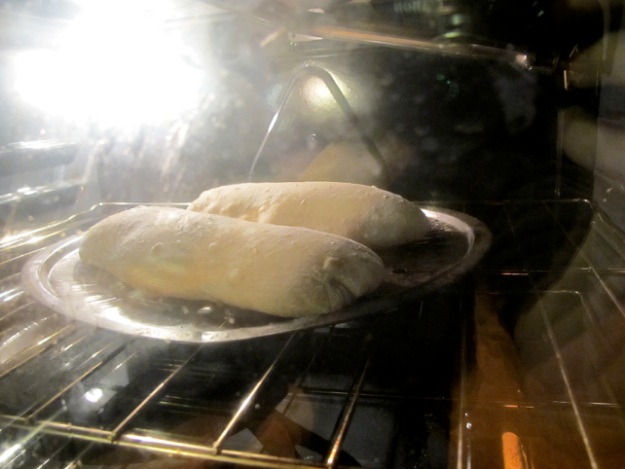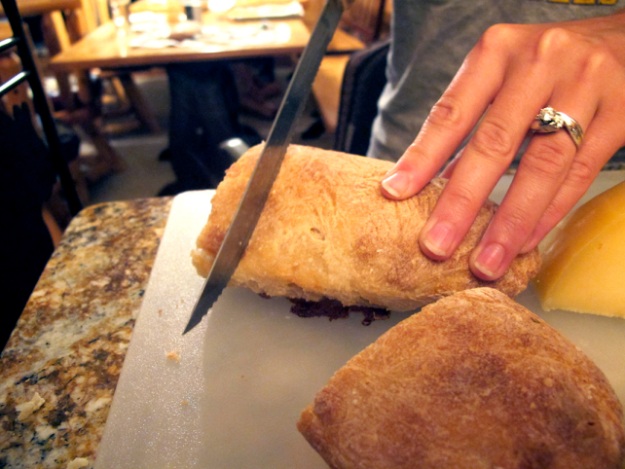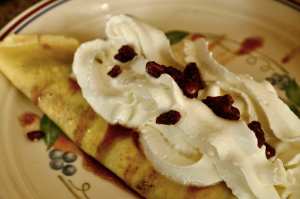 Please welcome the very first guest post on my blog, written by none other than my much loved and much blogged about sister Erica. Feel free to refer to her as ‘blondie pants,’ ‘spankeroo,’ or ‘schmantypants.’ I’m so excited to have her share this recipe. It makes the best bread I’ve ever tasted, and I’ve been bugging her to write about it ever since June 8th, the day I started this blog in the first place. And though I’ve destroyed our relationship by my consummate nagging, at least I squeezed this out of her before she decided never to talk to me again.
Please welcome the very first guest post on my blog, written by none other than my much loved and much blogged about sister Erica. Feel free to refer to her as ‘blondie pants,’ ‘spankeroo,’ or ‘schmantypants.’ I’m so excited to have her share this recipe. It makes the best bread I’ve ever tasted, and I’ve been bugging her to write about it ever since June 8th, the day I started this blog in the first place. And though I’ve destroyed our relationship by my consummate nagging, at least I squeezed this out of her before she decided never to talk to me again.
Just kidding! She gave it over to my blog willingly–that’s how a well-trained younger sister behaves. Without further ado, I hand things over to this extremely kitchen-competent wonderwoman.
Pain à l’Ancienne means “Old style bread.” It’s also known as: Bread So Good You Will Never Go Back To The Bread Machine.
I discovered this bread while working at the IU Opera and Ballet Theatre’s costume shop as a seamstress with just about the most wonderful ladies ever. It showed up at most of our (frequent) potlucks, and we all looked forward to its appearance with much eagerness and salivation. When I moved on to grad school and no longer had time to say my own name, much less work at the shop, I finally wheedled the recipe out of the woman who made it, to my great delight. After whipping up lots and lots of batches and making some slight modifications to the recipe, I give you The Best Bread You Can Easily Make At Home Which Will Win You Many Friends And Followers–And Possibly A Nobel Prize.
The bread is incredibly simple to make; all it requires is a tiny bit of forethought, since you will start it the day before you wish to bake it. I tried par-baking it once, then freezing it, so that I could pop it into the oven without delay whenever the need arose, but I like it fresh much, much better. To par-bake it (if you choose to follow that dark and crunchy path), simply bake it for about half the time you usually would, let it cool, wrap tightly in plastic wrap or a ziploc, and freeze it. Then all you have to do is let it thaw for a bit before resuming the baking process whenever you are in need of really awesome bread at the drop of a hat. I found that the crust was much thicker and less delicious than when made fresh, but it’s till darn good.
 So, what does it take to make this bread, you ask? Not much, sez I.
So, what does it take to make this bread, you ask? Not much, sez I.
Ingredients
6 c. (i.e. 27 oz.) unbleached bread flour (MUST be bread flour- I like to use Gold Medal’s Better for Bread, but any flour specifically meant for bread will work)
1 ¾ tsp yeast (about one package, the dry active kind, not the instant or bread machine kind)
1 TBS vital wheat gluten
2 ¼ tsp salt
2 ½ to 3 c ICE COLD water
Let’s begin!
First, measure all your dry ingredients into a large mixing bowl. I like to give ‘em a nice whisk about to blend them well before adding the water. This way we don’t end up with unfortunate salty lumps. However, the great thing about this bread is that you don’t have to be über precise. Pile it all in. Mix it around. Call it a day. Then add the water. It does need to be ice cold- I always end up putting cold tap water in a bowl with a bunch of ice cubes and measure out the quantity I need, but I suppose you can use cold water from your fridge, too. That would be way easier. Once it’s been added, stir it with a spoon until it’s fairly uniform. The dough will be very sticky, so I tend to add a little less than the maximum 3 cup amount, and if it’s too dry, add a little more. Anyway, this is floppy, sticky dough that will get your hands all gummy. Last time I made this bread a week or two ago, I used my Kitchen Aid mixer with the paddle attachment to mix it and the dough hook to knead it. It worked really well, but I’ve been making this bread without fancy equipment for several years and it doesn’t make a difference what you use. The Kitchen Aid just makes your hands less gross.
So. Once mixed, put a generous quantity of your bread flour on the counter top and plop the squishy dough onto it. Then, begin to knead. You’ll probably find yourself using quite a bit more flour so that 90% of it doesn’t end up on your hands, but try to keep the excess flour to a minimum. Once the dough is smooth and elastic, and still quite sticky (or after 6-8 minutes of hand-kneading), lightly grease another clean mixing bowl and put the dough into it. Cover your bowl with plastic wrap and pop it all into the fridge. Leave it there overnight. The longest I’ve left it in the fridge is about a day and a half, but if you leave it in a little longer it can only increase the goodness. I wouldn’t abandon it for more than two days, though.
When you take it out of the fridge, you’ll notice that big, beautiful bubbles have formed in the dough. Yummmmmm. Don’t do anything to it yet, just set it in a warm place and let it rise. Since the dough is cold, it will take quite a bit longer than your average rising time since it first has to warm up. But that’s ok because it’s totally worth it. Mine usually rises for a good 3 hours. Last time I turned my oven on the lowest setting, put the bowl in, plastic wrap and all, and turned the oven off after 2 or 3 minutes. This works well because the small space retains the heat nicely.
Once your dough has doubled in size and is smelling all yeasty and glorious, take it out of the oven (if that’s where you were letting it rise). Don’t punch it down! Now, fill a cast iron or sturdy metal baking pan with water, and put it in your oven. We’ll put the bread on the lower rack, so it’s ok to put the rack with the water on it fairly high in the oven. We want the steam from the evaporating water, as this will make the crust crunchy and beautiful. Preheat to about 475 Fahrenheit, and while the oven preheats, we’ll prep the loaves.
 Personally, I like generously sized wider loaves rather than baguettes with this bread. You can do whatever you like, though. If doing baguettes, you can get about 5 shorter loaves from this recipe; otherwise, divide the dough into three lumps. It will be quite squishy and floppy, and won’t hold its shape too well. What we REALLY DON’T want is to squeeze or squash the dough too much. We want to keep those big air bubbles that have formed overnight, so be gentle with it. If you have a holey pizza pan, this is the time to use it. Otherwise a cookie sheet with some cornmeal sprinkled on it will do just fine. I bet a pizza stone would be great too, so use yours if you have one- just put the pizza stone in the oven with a light dusting of cornmeal when you put the water in, and slip the loaves onto it when the oven is ready. Otherwise, gently place the loaves onto your cornmealed pan and pop it in the oven.
Personally, I like generously sized wider loaves rather than baguettes with this bread. You can do whatever you like, though. If doing baguettes, you can get about 5 shorter loaves from this recipe; otherwise, divide the dough into three lumps. It will be quite squishy and floppy, and won’t hold its shape too well. What we REALLY DON’T want is to squeeze or squash the dough too much. We want to keep those big air bubbles that have formed overnight, so be gentle with it. If you have a holey pizza pan, this is the time to use it. Otherwise a cookie sheet with some cornmeal sprinkled on it will do just fine. I bet a pizza stone would be great too, so use yours if you have one- just put the pizza stone in the oven with a light dusting of cornmeal when you put the water in, and slip the loaves onto it when the oven is ready. Otherwise, gently place the loaves onto your cornmealed pan and pop it in the oven.
 A word about the baking: these loaves will rise a lot, and expand slightly sideways too. I always have to bake them in several rounds–they don’t usually fit on a single pan. As the loaves bake (judge the doneness by color), usually 20-30 minutes depending on the size of the loaf, you’ll need to use a water spritzer to spray the loaves 4-5 times throughout the baking time. You can find one in the laundry aisle of most stores, near the ironing stuff. The steam from the pan is great, but we need a little extra. Plus, it’s fun. Don’t be afraid to aim directly at the bread. A word of caution: it is very hot, so be careful as the steam might cloud up on you when you spray. The loaves will become a lovely deep golden or light brown color. Let them cool slightly if you can- a true test of your self-control- and then….devour!
A word about the baking: these loaves will rise a lot, and expand slightly sideways too. I always have to bake them in several rounds–they don’t usually fit on a single pan. As the loaves bake (judge the doneness by color), usually 20-30 minutes depending on the size of the loaf, you’ll need to use a water spritzer to spray the loaves 4-5 times throughout the baking time. You can find one in the laundry aisle of most stores, near the ironing stuff. The steam from the pan is great, but we need a little extra. Plus, it’s fun. Don’t be afraid to aim directly at the bread. A word of caution: it is very hot, so be careful as the steam might cloud up on you when you spray. The loaves will become a lovely deep golden or light brown color. Let them cool slightly if you can- a true test of your self-control- and then….devour!
 That’s about it. It sounds way more complicated from my instructions than it really is, but once you try it out you’ll see not only how easy it is to make, but how incredibly delicious the bread is. I mean, the tastiness-to-difficulty ratio is totally in your favor. Oh my, just you wait! The smell is divine, and the bread has the perfect slight crunch to the crust and beautiful texture to the inside . . . mmmm . . . Plus, I find bread making to be a wonderful, peaceful thing that is utterly satisfying, especially when shared. You can’t beat the homey and intoxicating smell of homemade bread that fills you house (and your soul!).
That’s about it. It sounds way more complicated from my instructions than it really is, but once you try it out you’ll see not only how easy it is to make, but how incredibly delicious the bread is. I mean, the tastiness-to-difficulty ratio is totally in your favor. Oh my, just you wait! The smell is divine, and the bread has the perfect slight crunch to the crust and beautiful texture to the inside . . . mmmm . . . Plus, I find bread making to be a wonderful, peaceful thing that is utterly satisfying, especially when shared. You can’t beat the homey and intoxicating smell of homemade bread that fills you house (and your soul!).
So make it! Tomorrow! (start it tonight!!) You won’t regret it. I promise.
And I won’t even TELL you how awesome it is with little pat of butter melting on it, still hot from the oven……
 Click here for printer-friendly version: Pain à l’Ancienne
Click here for printer-friendly version: Pain à l’Ancienne








